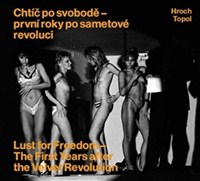Úvod »Cestovný ruch» Chtíč po svobodě - první roky po sametové revoluci
Kompletné špecifikácie
Fotografie Pavla Hrocha a esej Jáchyma Topola zaznamenávají divoká léta po sametové revoluci v Praze, vzrušené období oslav nově nabyté svobody o pádu komunistického režimu v Československu. Emoce se z intimní zóny vnitřního exilu obyvatel dostaly na ulici, společně s mnoha potlačovanými tématy i recidivisty propuštěnými po prezidentské amnestii. Zmatek se mísí s radostí, chutí dělat vše, co se dřív nesmělo, bez řádu a pravidel, a jen s abstraktními a idealizovanými cíli. Pandánem souboru fotografií z porevoluční Prahy jsou snímky z demonstrací v Západním Berlíně, kde levicoví radikálové pod vlajkou Mao Ce-tunga spílají kapitalismu, a fotografie z protivládních demonstrací volajících po starých pořádcích v Moskvě. To vše byla střední a východní Evropa raných devadesátých let, plná euforie, iluzí a paradoxů.
The photographs of Pavel Hroch and Jáchym Topol’s essay record the wild years following the Velvet Revolution in Prague, an exciting time of celebrating the newfound freedom after the fall of the communist regime in Czechoslovakia. The emotions of the country’s inhabitants flowed out onto the streets from more personal zones, along with many other previously suppressed subjects – and also the many repeat offenders released by the president’s amnesty. Confusion was mixed with joy and with a desire to do everything that had been previously forbidden, with no order or rules and with no more than abstract and idealized objectives. A counterpart to Hroch’s photographs from post-revolution Prague are his pictures from demonstrations in West Berlin, where left-wing radicals spit on capitalism under the banner of Mao Zedong, and also his pictures from Moscow, where anti-government protesters were calling for a return to the old order. All this was Central and Eastern Europe in the early 1990s – a place full of euphoria, illusions, and paradoxes.





